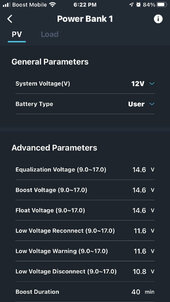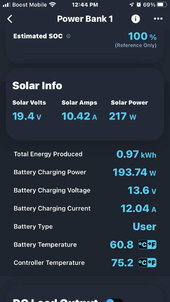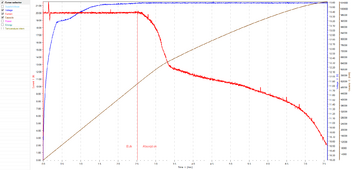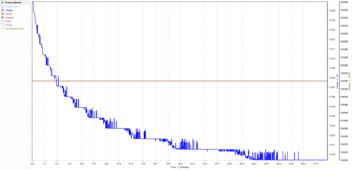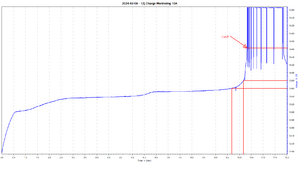hillbillytoker
New Member
Ok so I am having a really weird voltage drop on my 12v solar/battery set up. First I live in an apartment where I'm am limited on how I am allowed to set up my solar system. My solar system is a 12v system. I am running 2 100w renogy solar panels, a renogy Rover 30a Li MPPT solar controller, 2 12v 100ah LiTime LiFePo4 batteries, and an 2000w inverter (for the life of me the maker got it in a bundle deal).
Now for the weird voltage issue. I am unable to charge my batteries past 13.5v. While charging, it will go up to about 13.8v but then for no reason it will start dropping to 13.5 and then sit there with in an hour. At first I thought it could be the BMS's going into protection mode but after a long 2 weeks with LiTime support they determined it wasn't the BMS and thought it could be the solar system. Support made me do a deep drain cycle to make the BMS shut down to reset it but it still didn't work. Now before I got the Rover I had the Wanderer and just swapped it out believing it was the solar controller that was giving me the problem. I am still having the same issues that I was with the Wanderer. I then went through the whole system to see if I was having any parasitic draw. I found the both solar controllers where sending anywhere between. 0.05 to 0.1mv back to the solar panels when no sun was out. I placed 4 10a diodes in parallel to stop the draw. I then also found a 0.5 to 1v draw to the inverter even when the breaker was flipped off. Replacing it and now the draw is gone.
So now that I have fixed the parasitic draw issues I can still not charge past 13.5 without the voltage dropping and sitting at 13.5. Im at a loss of what it can be. I don't think its the solar panels. Only thing it can be is the wires but how can that be. Any help would be grateful.
Now for the weird voltage issue. I am unable to charge my batteries past 13.5v. While charging, it will go up to about 13.8v but then for no reason it will start dropping to 13.5 and then sit there with in an hour. At first I thought it could be the BMS's going into protection mode but after a long 2 weeks with LiTime support they determined it wasn't the BMS and thought it could be the solar system. Support made me do a deep drain cycle to make the BMS shut down to reset it but it still didn't work. Now before I got the Rover I had the Wanderer and just swapped it out believing it was the solar controller that was giving me the problem. I am still having the same issues that I was with the Wanderer. I then went through the whole system to see if I was having any parasitic draw. I found the both solar controllers where sending anywhere between. 0.05 to 0.1mv back to the solar panels when no sun was out. I placed 4 10a diodes in parallel to stop the draw. I then also found a 0.5 to 1v draw to the inverter even when the breaker was flipped off. Replacing it and now the draw is gone.
So now that I have fixed the parasitic draw issues I can still not charge past 13.5 without the voltage dropping and sitting at 13.5. Im at a loss of what it can be. I don't think its the solar panels. Only thing it can be is the wires but how can that be. Any help would be grateful.




